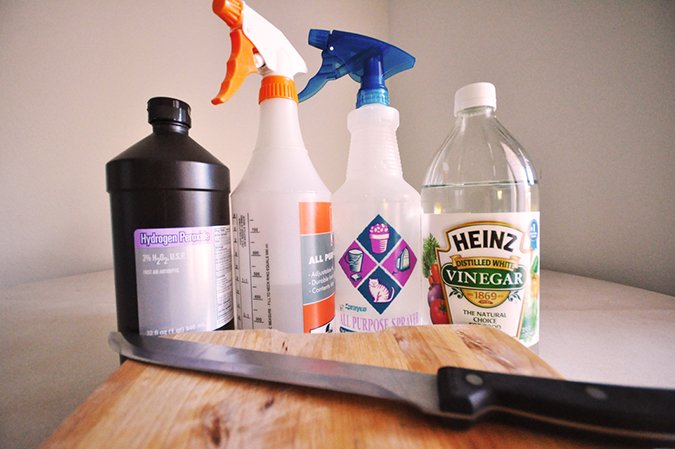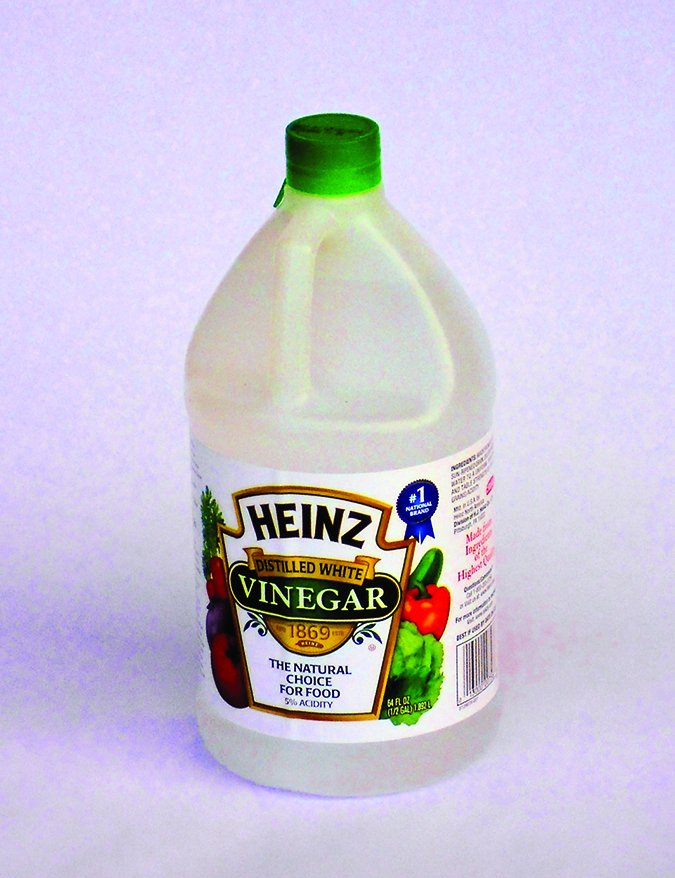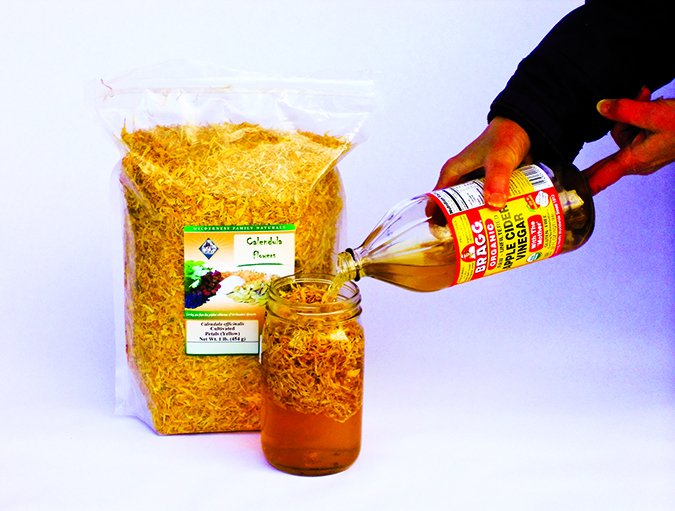People have been using vinegar for thousands of years, and while most of it goes into salads and condiments, vinegar can be used as a household cleanser, cosmetic aid, and health treatment. Many dog lovers add vinegar to their pets’ food or apply it topically to their best friend’s skin. Advocates call vinegar, especially unpasteurized organic apple cider vinegar, a wonder food. Is apple cider vinegar for dogs really a health-improving supplement, a natural preservative, a nontoxic cleaning product, a disinfectant, a source of important nutrients, and an effective topical treatment for canine ailments?

Some of the claims made by vinegar proponents are supported by research while others are not. Here are some facts about apple cider vinegar (ACV) and other vinegars to help you decide whether and when to use it for yourself and your dog.
How is Apple Cider Vinegar Different From Other Vinegars?
Its name comes from the Latin words vinum (which means wine) and acer (which means sour). Vinegar can be made from any liquid that contains sugar, which includes everything from fruit juice to plain sugar water. Within a few days of being exposed to air, naturally occurring or added yeasts cause the sugar to ferment, turning it into alcohol. If not interrupted, fermentation continues in response to naturally occurring or added acetic acid bacteria until all of the alcohol becomes acetic acid. This is how wine, beer, and ale are used to create wine and malt vinegars. Some vinegar factories shorten the fermentation process to just two or three days by using modern bacterial cultures and special pumps, but traditional vinegars valued for their culinary use are still made the old-fashioned way.
However it’s made, vinegar has a distinctive fragrance and a low pH. On the pH scale, water is neutral at 7.0, tomato juice is acid at 4.1, distilled white vinegar is more acid at 2.4, and the pH of lemon juice is 2.2. Apple cider vinegar tends to be less acidic, with a pH between 4.25 and 5.
One of the earliest known vinegars was made 5,000 years ago in Babylon from fermented dates. In ancient Rome, fermented rye, figs, grapes, and dates were popular ingredients. Today’s vinegars are made from corn, barley, and other grains; grapes; apples; and other fruits.
According to the Vinegar Institute, an international trade association representing vinegar manufacturers and bottlers, worldwide vinegar sales are now approaching $225 million annually, with the fastest growth in organic vinegars. Nearly half of the vinegar sold in North America is balsamic, with red wine vinegar the next most popular at 13 percent and cider vinegar tied with rice wine vinegar at 8 percent each.
Only 1 percent of sales go to distilled white vinegar. However, distilled white (usually made from corn) and distilled apple cider are the most familiar supermarket vinegars. These inexpensive vinegars are filtered and pasteurized to make them sparkling clear. Better-quality wine, cider, or malt vinegars are often aged for years in wooden barrels to improve their flavor and left unfiltered and unpasteurized.
To vinegar connoisseurs, there’s a world of difference between distilled or rapidly produced vinegar and traditionally made vinegars that are brewed slowly in small batches and aged to perfection. Some gourmet vinegars cost over $200 per 100 milliliters (about 7 tablespoons).
Traditionally made organic apple cider vinegar is widely sold and far less expensive than gourmet balsamics, but it too is valued for its culinary uses. Some popular brands, such as Bragg, Spectrum, Eden Organics, Solana Gold Organics, and Dynamic Health, are made from organic apples that are crushed to make cider, then aged in wooden barrels.
Because it is raw and unfiltered, this vinegar is not clear like distilled vinegars. Instead, it contains a dark, cloudy substance that resembles dusty cobwebs. This substance, called the “mother” or “mother veil,” consists of naturally occurring pectin and apple residues whose protein molecules are connected in strand-like chains. As the Bragg website explains, “The presence of the mother shows that the best part of the apple has not been destroyed. Vinegars containing the mother contain enzymes that other vinegars may not contain due to over-processing, filtration, and overheating.”
Apple cider vinegar is usually light golden brown or orange in color. While the acidity of homemade cider vinegar varies, most manufacturers maintain a 5-percent acetic acid level, which is recommended for the safe pickling and preserving of low-acid foods.
Apple Cider Vinegar Helps Digestion and Blood Sugar
Vinegar has been used medicinally since ancient times. Roman soldiers valued vinegar and water as an antiseptic health drink. Hippocrates, the famous Greek physician, prescribed vinegar as medicine.
Advocates credit apple cider vinegar as a nutritional powerhouse, containing an array of vitamins, minerals, and bioflavonoids, but this is inaccurate. The USDA considers all of those nutrients as absent from ACV, with one exception: potassium. Raw cider vinegar contains about 11 mg potassium per tablespoon (the Daily Reference Value for potassium is 4,600 mg).

One way in which vinegar promotes health is through its effect on digestion. By itself vinegar may not contain significant vitamins and minerals, but when combined with foods that do, it helps the body assimilate those nutrients. Acetic acid, like other acids, can increase the body’s absorption of calcium and other minerals. Some nutrition experts, including Donna Gates, author of the Body Ecology Diet, recommend sipping 1 teaspoon apple cider vinegar in a glass of warm water while eating protein in order to stimulate the body’s production of hydrochloric acid for enhanced digestion.
Vinegar has important antiseptic properties that help prevent the growth of harmful bacteria and viruses in the digestive tract. As a bonus, it does not interfere with the body’s beneficial bacteria, which are the immune system’s first line of defense against harmful microbes.
In 2010, the Annals of Nutrition and Metabolism published a study showing that vinegar’s antiglycemic properties reduce blood sugar levels that rise after meals in healthy adults. These results agree with a 2006 Japanese study that showed that the consumption of vinegar with food prevented blood sugar level increases.
A 2005 study at Arizona State University tested patients with type 2 diabetes, prediabetes, or no symptoms of diabetes, as they consumed a breakfast containing 87 grams of carbohydrates just after drinking a glass of water containing either 2 tablespoons apple cider vinegar or a placebo. Apple cider vinegar water consumption slowed the rise of blood sugar in all three groups, up to 34 percent. Based on studies done with rats or in test tubes, the researchers speculate that vinegar interferes with the absorption of high-carbohydrate foods.
No one is suggesting that vinegar cures diabetes, but the studies mentioned above encourage researchers to further examine the effect of vinegar on blood sugar levels.
Fighting Germs with Apple Cider Vinegar
In 2007 the well-known food magazine Cook’s Illustrated compared four ways of cleaning produce to determine which is most effective for removing bacteria: washing with antibacterial soap; washing with a solution of 1 part vinegar and 3 parts water; scrubbing produce with a brush; and simply rinsing produce in clean water. The “dilute vinegar solution” worked best, removing 98 percent of bacteria.
In 2003 researchers at the University of Florida tested several disinfectants on strawberries contaminated with Salmonella, E. coli, and other germs. They found that gently swishing the strawberries for 2 minutes in a 10-percent vinegar solution (about 1/2 cup vinegar per quart of water) reduced bacteria by 90 percent and viruses by 95 percent.
Researchers at the University of Arkansas Food Safety Consortium studying methods for manufacturing natural or organic cured pork products found that mixtures of vinegar with lactate and vinegar with lemon powder inhibited bacterial pathogens such as Listeria monocytogenes.
In a 2010 Danish experiment, chicken broiler meat was inoculated with Campylobacter jejuni and marinated with different food ingredients, including wine vinegar. Only the vinegar maintained its antibacterial activity during three days of storage, reducing the C. jejuni population.

A Spanish study published in 2007 examined the antimicrobial activity of several products, including vinegar, against Staphylococcus aureus, Listeria monocytogenes, Salmonella enteritidis, E. coli 0157:h7, Shigella sonnei, and Yersinia spp. Vinegar showed the strongest antibacterial activity.
Vinegar isn’t the only inexpensive household product with disinfecting properties. Hydrogen peroxide (the 3 percent solution sold in supermarkets and pharmacies for wound healing) is another. In the 1990s, when the 0157:H7 strain of E. coli first sickened thousands around the world, Virginia Polytechnic Institute and State University food scientist Susan Sumner, PhD, discovered that spraying vinegar and hydrogen peroxide on raw meat, vegetables, cutting boards, and other kitchen surfaces disinfected them more effectively than chlorine bleach or any commercial kitchen cleaner. Applying one after the other (in either order) with a mist sprayer killed virtually all Salmonella, Shigella, and E. coli bacteria on heavily contaminated food and surfaces. The one-two punch was 10 times more effective than using either vinegar or hydrogen peroxide alone, and more effective than mixing the two substances together in one sprayer, which is not recommended.
On most foods and kitchen surfaces, no rinsing is necessary. Spraying the vinegar first, then the hydrogen peroxide, is an easy way to reduce or remove vinegar’s fragrance if necessary. (Note that vinegar’s acid can etch marble and natural stone, so it is not appropriate for all surfaces.)
How Apple Cider Vinegar Helps Dogs
Vinegar has long been used as a first-aid treatment. Many natural health experts prefer raw organic apple cider vinegar for topical applications, including muscle aches and bruises; sunburn, windburn, abrasions, insect bites, and stings; and hair care (controlling dandruff and improving condition and static control).
Nearly all of vinegar’s human uses can be applied to pets. Because puppies and some dogs have sensitive skin, test a small area by applying vinegar or a vinegar-based herbal tincture (liquid concentrate) recommended for topical use. Check the area every few hours for up to 24 hours. If redness or irritation develops, dilute the vinegar and try again or discontinue use. This type of patch test is not necessary when applying vinegar that will be washed or rinsed off within a few minutes.
Make Your Own Apple Cider Vinegar Insect Repellent
– Does vinegar kill fleas? No, but they sure don’t like it. Plain vinegar and herbal tinctures containing cider vinegar repel insects, including fleas and mosquitoes. Spray the neck, torso, tail, underbelly, and overall coat (avoid the eyes, nose, and mouth) and let dry.
-For a nontoxic flea dip, cover your dog or puppy with ACV (spray, sponge, or simply pour it on), working it into the skin and coat. Avoid the eyes, nose, and mouth. Let stand for several minutes before washing with gentle shampoo.
-Dab full-strength cider vinegar or a cider vinegar herbal tincture behind the ears, near the tail, and on the dog’s coat. Because herbal tinctures and cider vinegar can stain light or white coats, substitute distilled white vinegar for light-coated dogs.
Cleaning Pet Stains and Odors with ACV
-Mix 1 part distilled white vinegar with 3 parts water. Pour onto carpet or other stained areas and blot with fabric or paper towels. Do not rub.
-Refresh and deodorize pet bedding by spraying it with vinegar or by adding vinegar to laundry when washing bedding.
-Clean and disinfect pet toys by spraying lightly, then brushing or wiping clean.
-Vinegar is often recommended as a pet deodorizer. Apply diluted or full-strength vinegar to any stinky coat and let the dog air-dry.
If your dog rolled on well-rotted mammal parts or got sprayed by a skunk, mix 1 freshly opened quart of 3-percent hydrogen peroxide in a plastic container with 1/4 cup baking soda and 1 teaspoon liquid soap. Wearing protective gloves, cover the dog while avoiding the nose, eyes, and mouth, then rinse with plain water. If any fragrance lingers (as it did when my Labrador recently rolled on a decomposing carp), apply vinegar to complete the process.
Apple Cider Vinegar Skin and Coat Treatments
–After shampooing your dog, give him a final rinse with 1 cup vinegar diluted in 2 to 4 cups water. Experiment with different dilutions for best results.
-Reduce your dog’s dander by massaging full-strength cider vinegar into the coat before shampooing.
-Apply full-strength or diluted ACV to calluses, rough skin, sunburn, or skin irritations.
-Combine skin-friendly herbs like calendula blossoms, St. John’s wort blossoms, and/or comfrey leaves with ACV to improve its healing effects on cuts, wounds, abrasions, etc.
-Wendy Volhard, author of Holistic Guide for a Healthy Dog, recommends spraying itchy skin and developing hot spots with apple cider vinegar. “Any skin eruption will dry up in 24 hours,” she says, “and will save you having to shave the dog. If the skin is already broken, dilute ACV with an equal amount of water and spray on.”
Apple Cider Vinegar for Itchy Feet or Ears
-Dogs with seasonal allergies can develop itchy feet in response to pollen exposure. Soaking the paws in full-strength or diluted ACV can help reduce the itching.
-Plain apple cider vinegar or a vinegar-based herbal tincture can help keep a dog’s ears clean and healthy. Place a few drops in each ear and gently massage, or apply with a cotton swab. For a more medicinal ear drop, make or buy a cider vinegar tincture containing ear-friendly herbs like garlic and mullein blossoms.
ACV for Muscle Sprains in Dogs
-Apply cider vinegar to sore muscles with a sponge or cotton. Do the same for bruises, abrasions, sore paw pads, and other discomforts. Reapply as needed.
Apple Cider Vinegar for Cleaning Raw Dog Food
If you feed a raw home-prepared diet and are concerned about harmful bacteria in your dog’s food or on kitchen surfaces, use the alternating vinegar-peroxide spray treatment described above.
“I always add raw apple cider vinegar to vegetables when I puree them for my dogs,” says veterinary technician Adele Delp of Helena, Montana. “Vinegar is a natural preservative and the vegetables last several days longer in the refrigerator, which is convenient.”
There are pros and cons to adding cider vinegar to a dog’s drinking water, with the recommended dose usually 1 teaspoon to 1 tablespoon per 50 pounds of body weight. “People often talk about adding ACV to water bowls,” says canine health researcher Mary Straus. “My feeling is that if so, you should also offer plain water, just in case your dogs don’t want to drink the apple cider vinegar water. You wouldn’t want to risk their drinking less water and possibly becoming dehydrated.”
Is a daily dose of apple cider vinegar good for your dog? Unless your dog is allergic to apples, he or she isn’t likely to suffer a serious reaction, and within a month you should be able to tell whether the addition is helping. Commonly reported benefits include improvements in skin and coat condition, a reduction of itching and scratching, the elimination of tear stains on the face, fewer brown or yellow urine spots in lawns, increased mobility in older dogs, reduced flea populations, and an improvement in overall health. A simple tablespoon of apple cider vinegar and honey a day could be enough to show marked improvements in the quality of your dog’s skin and fur.
Apple Cider Vinegar Tincture Recipes for Dogs
Rosemary Gladstar, a well-known herbalist, educator, author, and dog lover in East Barre, Vermont, values raw organic apple cider vinegar for its use in herbal tinctures. “These highly concentrated liquid extracts of herbs are easy to make, simple to administer, and convenient,” she explains. “Their prolonged shelf life makes them easy to keep on hand.”
Alcohol is the most widely used tincture solvent because it extracts fats, resins, waxes, most alkaloids, some volatile oils, and other plant components, which it preserves indefinitely. Vegetable glycerin, a sweet, syrupy liquid, dissolves mucilage, vitamins, and minerals but does not dissolve resinous or oily plant constituents. Apple cider vinegar extracts sugars, tannins, glycosides, bitter compounds, alkaloids, vitamins, and minerals.
“Cider vinegar is not as strong as alcohol and does not break down all of the plant components,” says Gladstar, “but there are advantages to using it. Vinegar is a food, 100 percent nontoxic, and tolerated by almost everyone. It helps regulate the acid/alkaline balance in our bodies and is an excellent tonic for the digestive tract. Vinegar tinctures are a fine alternative for those who are sensitive to alcohol and they can safely be used for children and pets. Add a little honey to your vinegar tonic for a nice flavor. Though vinegar tinctures may not be as concentrated as alcohol tinctures, I trust in the body’s ability to discern what it needs and to use it effectively.”
Although most herbal literature warns that vinegar tinctures have a shelf life of only six months before deteriorating, Gladstar disagrees. “My personal experience,” she says, “and that of many of my peers has been that vinegar tinctures will last, if stored in a cool, dark place, for several years. I have vinegar tinctures that are up to four years old and they are still in excellent condition.”
In her book, Herbal Recipes for Vibrant Health, Gladstar describes the traditional or simpler’s method of tincture making, which she prefers. All you need are herbs, the appropriate menstruum (alcohol, vinegar, or glycerin base), and a jar with a tight-fitting lid. “This extremely simple system produces a beautiful tincture every time,” she says.
1. Chop herbs finely. Fresh herbs work best but high-quality dried herbs are next best. Place them in a clean, dry jar. If using dried herbs, fill the jar only half way to allow for expansion.
2. Heat raw organic ACV to a warm (not hot) temperature. Pour in enough to completely cover the herbs with a margin of 2 or 3 inches. Seal the lid.
3. Leave the jar in a warm spot and let the herbs soak for 4 to 6 weeks – the longer, the better. Shake the bottle daily.
4. Strain the liquid through a stainless steel strainer lined with cheesecloth or muslin. Place in dark cobalt or amber glass bottles, label, and store away from heat and light.
Herbs such as burdock, chamomile, dandelion, echinacea, ginger, mullein, nettle, sage, slippery elm bark, valerian, and yellow dock added to food can help dogs improve their overall health, enhance digestion, and deal more comfortably with stress.
Gladstar recommends a garlic/dandelion vinegar tincture as a general tonic and to help dogs repel parasites. Use fresh or dried dandelion leaves, roots, and blossoms with an approximately equal amount of garlic. (If using dried dandelion, leave ample room for expansion.)
Add this tincture in small amounts to your dog’s food, gradually increasing to approximately 1/4 teaspoon per 20 pounds of body weight per day. The dandelion is a tonic for the entire body (it helps improve digestion, cleanses the blood, and supports kidney function), while garlic repels internal and external parasites and acts as a digestive and circulatory tonic. If desired, make a double-strength tincture by straining the completed tincture into a new jar of freshly chopped garlic and dandelion, repeating the process. Reduce the dosage accordingly.
An effective liniment warms and relaxes joints and muscles, increases circulation to the area, relieves inflammation, improves flexibility, and speeds healing. Traditional recipes combine skin-warming ingredients and therapeutic herbs with cider vinegar. For example, combine 1 pint (2 cups) apple cider vinegar with 1 teaspoon powdered cayenne pepper, 4 tablespoons dried (or 1/4 cup fresh) rosemary, and 2 tablespoons dried (or 1/8 cup fresh) comfrey leaf or root that has been cut or broken into small pieces. Massage into tight muscles, bruises, or sore joints, or simply soak a cloth or bandage in the liniment and hold it on the affected area for as long as possible. Keep this liniment away from the eyes and mucous membranes.
Gladstar’s favorite cider vinegar tincture is an herbal cosmetic, Queen of Hungary’s Water. “Legend has it that the early Roma people of eastern Europe formulated it and claimed it to be a cure-all,” she says. “It is an excellent astringent for the face and a great rinse for dark hair. It combines gentle, common herbs in a masterful way, it’s easy and inexpensive to make, and it’s very versatile. The Roma claimed it was good as a hair rinse, mouthwash, headache remedy, aftershave, foot bath, and who knows what else!”
To make it, combine 6 parts lemon balm, 4 parts chamomile, 1 part rosemary, 3 parts calendula, 4 parts roses, 1 part lemon peel, 1 part sage, and 3 parts comfrey leaf. After aging and straining, add 1/2 to 1 cup rose water or witch hazel to each cup of herbal vinegar. Store in dropper or spray bottles. This product does not need refrigeration and will stay fresh indefinitely. (Because it stains, this blend is not recommended for light or white hair.)
Using Vinegar for Cleaning
As Patricia Bragg says, “We don’t endorse white vinegar or dead vinegars for human or pet use, internally or externally! But it’s great for a variety of household, workshop, and pet cleanup chores. White vinegar is a safe, effective, and inexpensive household cleaner, deodorizer, and disinfectant, which replaces commercial household cleaners that are full of chemicals and additives that are harmful to Mother Nature and you. Remember: use only the healthiest vinegar, like Bragg raw organic ACV (with ‘mother enzyme’) for all human consumption and for use on skin, hair, and your pets.”
Because dogs contact household surfaces directly and indirectly, chemical exposure is always a consideration. Distilled white vinegar is so versatile that some reports list more than 400 household applications. Get just a few of them here!
Freelance writer CJ Puotinen lives in Montana. She is the author of The Encyclopedia of Natural Pet Care and other books.






What does ‘cleanses the blood’ mean?
It’s means that apple cider vinegar removes uric acid from the blood and purifies toxins from inside the body
Great info, thank you!!
Thank you very much for taking your time in compiling and sharing this vital information!
I am fearful that I may be losing my sweet elder girl, India due to an enlarged fatty liver. I have begun walking with her to get her weight down. I consume Braggs instead of lemon and find it literally melts the fat off so why wouldn’t it work for my friend. However she doesn’t like the taste of the water with the vinegar but I firmly believe it would take the fat off her liver. Please help! Is there a recipe where I might make treats that won’t make her fat, but that the vinegar is in there? I stress that she is already overweight (my cupboard love fault!) so a no bake think low in fat and carbs but with the braggs in? Ps. As for me if I have to cook it, I eat cereal instead…for my dogs I’ll cook all day so please if you can concoct a liver friendly no weight gain braggs dosed treat I’ll do it! hank you so much!
Thanks very for this insightful information